

Suunto Blog

Fuelling the engine: a commonsense approach to nutrition
Eating well is essential for athletes. The bigger your goal, the more nutrition has to play a central part of your training plan. Take shortcuts on how you eat, and you’ll eventually pay for it.
But the topic of diet, what we should and shouldn’t eat, has become touchy and confusing. There are all sorts of diets out there – paleolithic, vegan, gluten-free, low carb, high carb – each one with advocates claiming their way is the one true way.
Matias Anthoni prefers a common sense approach to nutrition.
“Nowadays it’s become a big topic, and everyone has his or her own opinion, and it seems hard to find the real truth,” says Matias Anthoni, Suunto’s in-house personal trainer. “It’s become trendy to follow a kind of diet.”
Anthoni, 26, has a Bachelor in Sports and Health Promotion, and gives nutritional advice to Suunto employees, as well as personal fitness training. He takes a simple, “nonsectarian” approach to nutrition, rather than buying into the hype of one diet over another.
“As long as you get the nutrients it doesn’t really matter what diet you follow,” he says. “You can teach your body to thrive on different diets. The body is quite adaptable. But we do need certain basics. The question I always ask is, would my grandma recognize it as food?”
Here are Anthoni’s five down-to-earth tips for good nutrition:
1. Start with your meal rhythm
This is the first topic Anthoni’s raises with his clients during a consultation. Just improving how often you eat can improve what you eat. Many of his clients skip meals or have long breaks between meals; this results in blood sugar levels dropping, then tiredness, and then cravings and impulses for unhealthy snacks.“With a more steady meal rhythm you avoid big spikes in the blood levels, make better decisions, and are less likely to just reach for a chocolate bar,” he says.
Meals should be about three hours apart, and consist of a good breakfast, lunch and dinner, with smaller, healthy snacks in between. “It leads to healthier choices and you’ll have more energy,” Anthoni says.
2. Plan ahead
“You can’t be a top athlete if you are eating poorly; it’s not just about training, it’s about eating as well,” Anthoni says. “It really helps if you plan your meals like you plan your training. Know what you are going to buy and know what you are going to make. When you come home from work, or after a training session, it’s all ready to go.”
3. Follow the Nordic plate model
Anthoni says in Finland there’s a traditional “plate model” or a way to divide your plate into three sections: one half should be salad and vegetables, one quarter should be carbohydrates, and one quarter protein. This balanced plate ensures you will get enough of all the key nutrients.
4. Eat quality food
Quality can seem like a vague notion, so Anthoni recommends a common sense approach here, too. “Have a look at your plate – are there all the colours – red, green, yellow?” he asks. “Are you eating the same thing every day?” Anthoni suggests finding and following basic nutrition guidelines. “They provide a good start, and then make small changes to fit yourself from there,” he says.
5. There’s no one size fits all diet
Deciding what to eat depends on your goals. “The more you move the more you need,” Anthoni says. “If your goal is building muscle mass, then you need more protein. If you are an endurance athlete, eating enough carbohydrates becomes more important. There is no one size fits all, no one plan can fit everyone. You need to have your own plan.”
Lead image: Photo by Roosa Kulju on Unsplash.
READ MORE
Fuelling the engine: talking nutrition with ultra runner Lucy Bartholomew
Fuelling the engine: talking nutrition with triathlete Mel Hauschildt
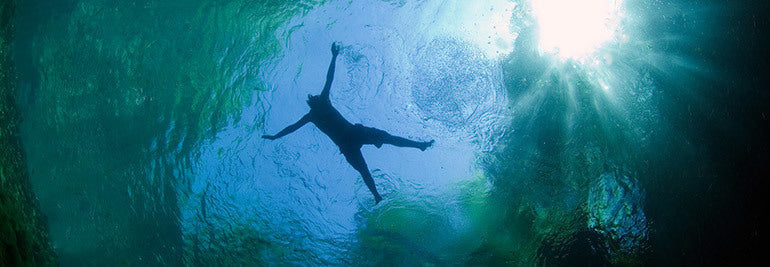
Committed to protecting the oceans together – Suunto joins Mission 2020
We are committed to protecting the environment and preventing pollution in our operations.
"Our guiding principles are the use of sustainable materials, reduction of waste, reduction of energy consumption and co-operation with the supply chain to foster human rights and working conditions," says Erika Rautavaara, Sustainability Manager at Suunto.
The most visible part of the responsibility are, in fact, our products.
"We only design and manufacture durable devices that can be used for a long time in very demanding conditions. In addition, all our equipment can be repaired, and maintenance and repairs can be easily done anywhere in the world. This is very exceptional in the world of electronics."
Juha Ala-Laurila, Dive Business Unit Director at Suunto, points out that responsibility work is a never-ending task.
"We are on a path that goes forward and changes its shape as the world around us changes."
Right now, we are expanding our responsibility operations beyond the limits of our own business.
"The plastic waste in the oceans is a huge problem, and, as a part of the diving community, we want to be involved in solving it," Juha says.
Mission 2020 sets targets
We participate in Mission 2020, a global initiative by organizations within the diving community to change their business practices in order to help protect and preserve the oceans for the future. Every company in the Mission 2020 community has agreed to make a binding commitment.
"Suunto commits to minimizing single-use plastics in the packaging and to select durable materials to ensure a long lifetime for products and capability for maintenance. We also commit to optimize deliveries and compensate carbon emissions from all deliveries. Through our certified and audited environmental management system we are and continue to be committed to save our common playground," Juha says.
With a primary focus on single-use plastic, the project sets ambitious short-term targets of changes to be made before World Oceans Day 2020.
"In the future, all our actions, operations and messages must be environmentally credible", Juha says.
Net-zero is not enough
Divers see the damage caused by human activity on the ocean environment more clearly than anyone else.
Many divers are also committed to solving the problem. One of them is Suunto Ambassador Jill Heinerth, a pioneering Canadian-American underwater explorer and filmmaker. She says that diving companies have a unique opportunity to lead the responsibility work by example in their daily practices.
However, diving companies have also more wide-spreading opportunities.
"Diving companies meet new environmentally-curious customers every day. Dive briefings can have an environmental message, and manufacturers can employ responsible packaging and process ethics. It is not just enough to talk about "net-zero" carbon impacts. We have to lead with net-positive actions," Jill explains.
"If we all talk about those efforts and recognize organizations that have a good ethic, then we can spread the word. Education, process and activism are all important prongs in the environmental ethic."
Daily choices affect ocean health
The problems associated with plastics, climate change, and water quality are massive.
"But I have to believe that we have hope to turn the tide. We don't have the luxury of time anymore. Action has to be swift and bold. Every consumer needs to downsize and vote with their wallets. Whether that means buying local, reducing packaging or making product choices that support the environment, every action will help," Jill says.
In her projects, Jill Heinerth has studied the importance of water to all of us.
"The most important message that I want to convey is that the issues we see in the ocean are connected to our everyday lives. Everything that we do on the surface of our landscape will eventually affect our water systems including the ocean. Choices we make in our daily lives affect ocean health. The effort to using fewer drinking straws is admirable, but it is just a start. We need to seek out alternatives to any plastics and move to use natural, biodegradable products as much as possible, even if they are more expensive. We need to lose the love affair with the golf course style lawn and stop using fertilizer, pesticides, and insecticides on the ground as much as possible. Those materials soak into the ground and flow toward water bodies creating massive algal blooms that kill wildlife and sicken people just like we are seeing in Florida right now."
www.IntoThePlanet.com
www.mission2020.org
All images: © Jill Heinerth
READ MORE
Ocean plastics are a problem and no one knows better than divers
Under thin ice: Jill Heinerth captures climate change
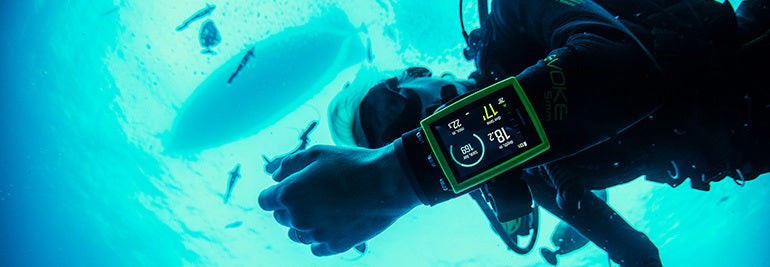
“Losing diving is like losing a limb”: Gemma Smith’s scrape with death and her incredible recovery
© Jukka Saarikorpi
Surgeons and specialists who’ve carried out 12 operations and other procedures on 27-year-old Gemma Smith since a car crashed into her have been astonished at how quickly she has recovered. Smith believes it’s in large part due to the massive kindness and support she has received from the diving community.
Fellow divers, for example, created a fundraising page for Smith to help her with her long recovery. At the time of writing they have raised nearly $10,000 USD.
Click here to support Gemma.
“The biggest thing I want to say to everyone is thank you,” says Smith, the first woman to dive the world famous Antikythera Shipwreck. “The support I have received from all over the world, from many people I’ve never met, has been so mind blowing. It’s beyond what I could have ever imagined.”
© Nina Baxa
When an elderly man died of an aneurysm at the wheel while driving in the Faroe Islands in March this year, his foot slipped on to the accelerator and the car veered off the road and into Smith and her friend as they were walking home from the shops for a movie night together. Thrown four meters by the impact, Smith, lucky to have survived, woke up in hospital, completely unaware of what had happened.
She suffered a bleed on the brain, a broken neck, a broken coccyx, both legs and both feet broken. With two e coli infections, Smith nearly lost a leg. Doctors doubted she would walk again, let alone don scuba gear and drop underwater.
But Smith is walking again, going to rehabilitation twice a week, and training to fulfill physical requirements set by doctors before they will allow her to dive again. Her determination is unshakeable.
Listen to Gemma talk about why she dives in the video below
Smith started diving when she was 17. Since then, this is the longest she has gone without a dive, and it hasn’t been easy accepting that.
“Not being able to dive is like losing a limb,” she says. “It’s not just that I’m missing my hobby, but part of me is missing. I'm really lucky, and I will never forget how lucky I am, but at the end of the day, my overriding goal and aim is to get back in the water.”
The harrowing experience, the loss of her ability to dive, the outpouring of support she has received from the dive community, has shifted Smith’s vision of her future as a diver. Diving will always be her life, but now she wants to focus on sharing diving with people who could really benefit from its healing qualities.
“When something this random and out of the blue happens, you definitely reassess what’s important and what’s not,” Smith says. “Whereas before the accident diving was driven solely by exploration and discovery, what I wanted when I was lying in hospital for weeks was simply to get into a swimming pool and just have that quiet. “I learned to appreciate that more than I had done before.
“My focus right now is to look at how to help people with PTSD (Post-Traumatic Stress Disorder) or who have been in horrible accidents, or had horrible experiences, through diving. I want to give people the opportunity to experience the wonder, freedom and calming influence that diving can bring to your life.”
Over the next year Smith’s plan is to get dive fit. First it will be a single tank dive in a pool. Then baby steps from there. And despite a warning from a neurosurgeon not to start anything new, Smith couldn’t resist beginning a degree in archeology. “I thought, ‘if I can't dive, this is not the end for me, I'm going to come at it from an archeological point of view’,” she says.
Everyone at Suunto wishes Gemma a speedy recovery and a wonderful first dive.
Lead images: © Jukka Saarikorpi
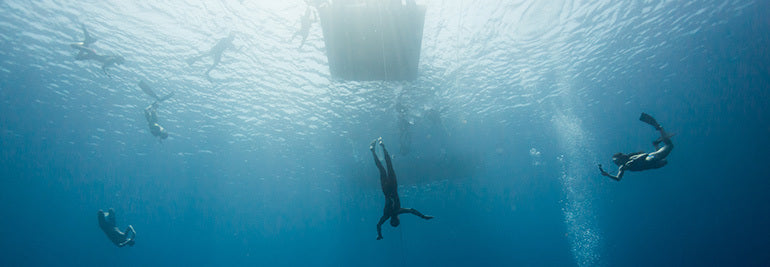
Drop below the surface into the depths with William Trubridge
Ask any freediver to explain what the experience of freediving is like and they will tell you words cannot do it justice. It's a transcendent sport – one that transforms our experience of the mind and our limits – and the subtlety of poetry is better suited to communicate what this unique experience is like.
“There’s nothing happening in your body that resembles any other sport or activity,” Suunto ambassador William Trubridge says in the video below. “What you are doing is perhaps the most alien thing the human body can do. Sure, if you went on a space walk, you are off the planet and weightless, but a free dive transforms you into another creature altogether.”
In the TEDx Talk below, Trubridge, who holds the world record for the deepest dive, guides his audience on a free dive, riffing poetically about the experience, how it feels, what happens to body and mind, and why he and other free divers are drawn away from the surface and into the deep.
Lead images: © Alex St Jean / Vertical Blue
Read more about freediving here:
How deep can we go?
You haven't understood free diving until you've read this.
William Trubridge talks record attempts and the art of freediving.
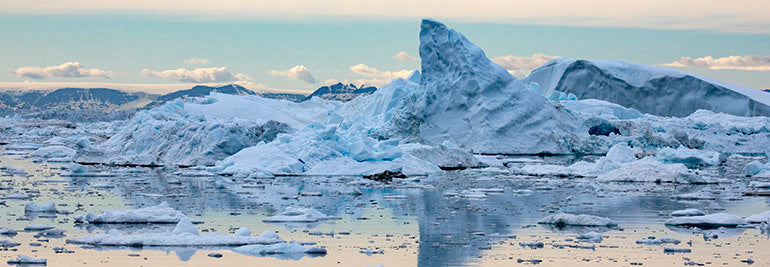
Under thin ice: Jill Heinerth captures climate change
Part of being an explorer is being away from home for long stretches. “Some people say that the two greatest times in the life of an explorer are leaving home and coming home,” Suunto ambassador Jill Heinerth says. “We will each feel loneliness and perhaps regret about moments away from those we love.”
“We feel an overwhelming imperative to document and share,” Jill Heinerth says.
But there are important reasons, sometimes for the greater good, that compel Heinerth and her peers to explore the ends, and depths of the planet. “We feel an overwhelming imperative to document and share,” she says. “When we have a chance to do really good work, telling important stories for humanity, then we are at the top of our game. Adventure fuels our souls.”
Telling an important story for humanity is behind Heinerth recently spending months in Greenland and the Canadian north. She has been on three expeditions to the Arctic to capture footage for an upcoming documentary film about the effects of climate change, called Under Thin Ice. She says the loss of sea ice is changing everything.
“The Arctic is warming faster than any other place on earth, so the changes are quite remarkable, even from year to year,” Heinerth says. “We learn from indigenous people that there are many new things they must adapt to. The sea ice disappears earlier each year. The multi-year ice is lessening and the migrations of fish and mammals are changing with the warming temperatures.
“Atlantic cod move further north into the territory of Arctic cod, competing for food. Bowhead and humpback whales are now seen in the same place at the same time. They used to arrive at different times, spread out by a couple of weeks. If everyone arrives at the buffet at the same time will they wipe out the food stocks? We know for sure that everything is changing.”
The sea ice disappears earlier each year.
Human-caused climate change is also impacting dive conditions, making it more challenging for Heinerth to do her job. “The bay in Ilulissat was filled with smaller bergs than normal, but it was choked with rapidly melting ice,” she says. “The freshwater mixes with seawater, creating a halocline that is difficult to focus through.”
“The melting ice also fizzes, filling the water with tiny bubbles. At times, we were in magically beautiful ice environments that were difficult to film. Warmer ocean temperatures also spawn more green algae that affects visibility.”
"It can take weeks or months of waiting to get the single opportunity for a great shot.”
“Any time you film marine mammals, there is a challenge of first finding them and then finding good and safe conditions for filming them. It can take weeks or months of waiting to get the single opportunity for a great shot.”
Heinerth, however, encountered more than enough wildlife for the documentary. On one day she got particularly lucky. Here is a passage from her journal on lucky day seven of her expedition to Nunavut, Canada’s northernmost territory:
Yesterday’s impossibly dangerous mess of jumbled ice is today’s floe edge, where ice meets the ocean. We are able to walk right to the margin and peer down into the black water. It is alive with narwhals and belugas. I spot a rare bowhead whale and we run for the cameras to try to capture the sight. The sounds are intense. Deep breathing and forced exhalations fill the air with moist spouts from dozens of blowholes. I can see narwhal intermingling with belugas and can hear the canary chirps of the white whales. Groups of seven or eight are huddled together on the surface talking and breathing up to prepare for a dive under the ice which appears to be about four to six feet thick.
Follow Jill Heinerth’s adventures on IntoThePlanet.com. And visit the official Facebook page for more information about the documentary Under Thin Ice.
GET BEHIND THE SCENES OF FILMING "UNDER THIN ICE"
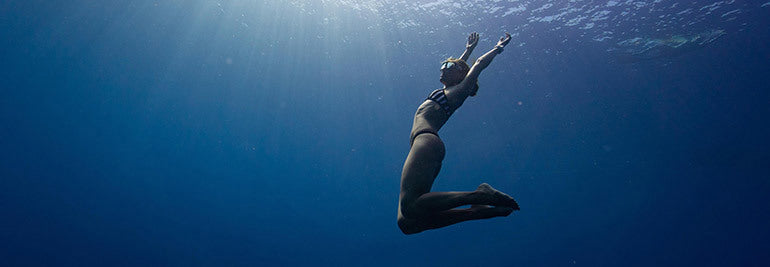
4 reasons rock climbers should learn freediving
© Mike Board
When an earthquake struck Indonesia in August, Kate Middleton’s home on the island Gili Trawangan (neighbouring Bali) was shaken, but not destroyed. “We were lucky to have very little damage, just a couple of walls in the yoga hall,” she says.
The 30-year-old Canadian-New Zealander owns a yoga studio, freediving school and organic cafe on the island. It’s in the clear waters, teeming with exotic marine life, around the island that Middleton trains as a competitive freediver.
Click here to donate to the Lombok Earthquake Support effort underway.
She wasn’t on Gili when the earthquake struck; she was thousands of kilometers away on a different island: Greece’s rock climbing mecca Kalymnous, in the southeastern Aegean sea.
“In 2015, I gifted myself a trip here to learn to rock climb,” the gold medalist says. “I did a beginners and intermediate course back to back, and was totally hooked. The following summer I returned and stayed for two months, climbing almost every day. Now I’m back again.”
© Kalyja Rain
Beginner’s mind
Currently working on climbing a grade 6c route, Middleton is focused on cultivating presence on her climbs, rather than being concerned about numbers and statistics. Competition freediving demands, structured, disciplined training, and what she calls a “monofocus”.
“What I love about both trail running and rock climbing is it’s really easy for me to maintain a ‘beginners mind’ with them,” Middleton says.
Here are her four reasons rock climbers should learn freediving
© Kate Middleton
1. Relaxing into it
The biggest challenge for people new to freediving is learning to relax. “Most of us know how to push and force our way into things, instead of knowing how to relax into our power,” Middleton says. In freediving, relaxation is key for being able to dive deeply on a single breath. Relaxation calms the breath and reduces the heart rate, which conserves oxygen. Tension, stress, force increase the heart rate, wasting energy and oxygen.
“I see where that crosses over into climbing,” she says. “I’ve seen my friends practically float up 50 m overhangs, and I feel they are relaxing into their ability, rather than forcing it. I also see a lot of climbers who climb in a different way, that is more aggressive, and that doesn’t seem to be as efficient or enjoyable.”
Click here to read more about Middelton’s yoga and freediving journey.
2. Breathing well
“Freediving gives you a really great awareness of your breathing and breathing patterns,” Middleton says. “Any time the breath is getting out of balance, maybe due to stress, it’s very easy to pick up on that. This has helped me a lot when I’m climbing. I notice when I’m in the crux of a climb, or when fear starts to edge in, and I start to hold my breath. I then take some deeper breaths, with a steadier rhythm, and then I come back to presence and can continue climbing.”
3. Mastering fear
“Freediving has given me such a sensitivity to what’s happening with me. Because relaxation is so critical for freediving, especial deep diving, I can see so clearly how fear manifests in the body and how tension escalates. If I can catch it early, then it’s a lot easier to regulate and work with.”
4. Finding your power
When most people hear about freediving it seems a little mad, dangerous, even suicidal. But in actual fact, learned properly, it is a safe sport that shows us we can do so much more than we believe. “What I’ve learned from freediving is this body is so capable,” Middleton says. “I know without me having to understand it, that my body knows how to adapt and wants to adapt. I thrive in these environments that aren’t our everyday comfortable spaces. That gives me a lot of trust.”
True grit
Middleton says it’s not only freediving helping her to climb, but vice versa, too. “I’m getting more grit from the climbing,” she says. “When I fall, it hurts a bit more. I have to want it more to get over the crux of a climb. I fail a lot more. It would be easy for me to give up and say it’s beyond me, and stick to easy climbs. I’m learning to tap into the inner determination and fire that really wants to overcome the hurdle.”
Lead image: © Mike Board
More stories about freediving:
Learning the joy of freediving.
Is the ultimate cross-training ... breathing?
The one thing every freediver needs.
How deep can we go?










































































